In this article, you will learn the correct term for the horse baby and you will learn more about baby horses and interesting facts about them. As a veterinarian and horse owner with horse breeding experience, I have great expertise with baby horses and I hope this post will be very helpful to you.
The Horse Family in Proper Equine Terminology
Here I will go through the correct definitions of the members of the horse family.
The Baby Horse: Foal
There is usually a special proper term for baby animals. The correct equestrian term for the baby horse is “Foal“. The term foal is used in all horse breeds. The word foal means a young animal of the horse family under one year old. The newborn horse is called a foal immediately after it is born until its first birthday.
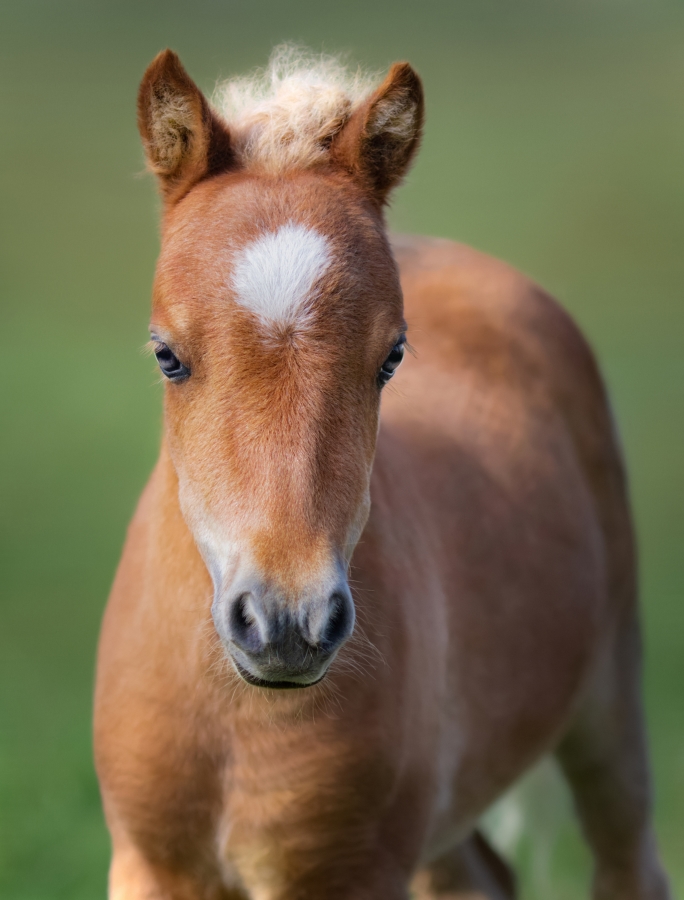
Many horse owners and breeders also call the fetus (the baby foal still in its mother’s uterus) a foal. The baby horse is called a foal during its first year of life. The term foal is also used for a baby donkey or a baby zebra. You can use the appropriate term foal for both a female foal and a male foal.

The Baby Horse Mother: Mare or Dam
The foal’s mother (the mother horse) is called the mare. All adult female horses are called mares. An adult female horse can also be called a dam if she is a mother of a foal.

The Baby Horse Father: Stallion
Adult male horses, the foal’s father, is called a stallion. As an intact male horse, the stallion is usually more muscular and has a thicker neck than the mare or gelding.

Gelding – a Castrated Stallion
A stallion may be gelded if it is not supposed to breed. A gelded horse is called a gelding regardless if it is a young or mature male horse.
Weanling – Weaned Young Horse
The term is used for a weaned horse that is less than one year old. Sometimes also called weanling foal. The horse is called a weanling when it has been separated from its mother and has stopped nursing. Used for both sexes.

The Horse Children – Yearling
Between the ages of one and two years, horse kids are called yearlings regardless of their sex. Long yearlings are closer to two years of age.
Youth – Filly and Colt
Young horses under four years of age have a special designation depending on their sex:
- Filly: A young female horse under the age of four
- Colt: A young male horse under the age of four.
The definitions can also be applied to a very young individual such as a filly foal (female baby horse) or colt foal (baby male horse).

Summary of Correct Terms in Relation to Age and Gender of the Horse
Here is a summary of different names used for horses. It is hard to know the correct term for a baby horse, an old horse, and everything in between. I hope this table will help you understand the various names.
| Age | Female | Male | Gelded male |
|---|---|---|---|
| 0-12 month | Foal | Foal | Foal |
| 0-4 year | Filly | Colt | Colt/Gelding |
| Weaning – 1 year | Weanling | Weanling | Weanling |
| 1-2 year | Yearling | Yearling | Yearling |
| >4 year | Mare | Stallion | Gelding |
Before the Foal (Baby Horse) Is Born
Gestation Period
The normal gestation period for a female horse is about 340 days (320-360). Generally speaking, it is more dangerous if the foal is born prematurely than if the mare goes overdue and the foal stays in the belly longer. It has been described that mares are pregnant for more than a year before healthy foals are born. In the Northern Hemisphere, most foals are born naturally in early spring to early summer, while in the Southern Hemisphere most foals are born in late summer to autumn. This is determined by the horses’ estrus cycle.

Photo: “Mare in the sunset light” by Tambako the Jaguar is licensed under CC BY-ND 2.0.
The Mare is Preparing for Giving Birth
Before the foal is born, the pregnant mare is preparing for foaling:
- About a month before foaling, the udder starts to grow
- About two weeks before foaling, the udder begins to fill with milk
- In the days before foaling, the mare may show restlessness, slight symptoms of colic, and pelvic ligament relaxation.
- 1-2 days before foaling you may see waxing – wax plugs on the mare’s teats
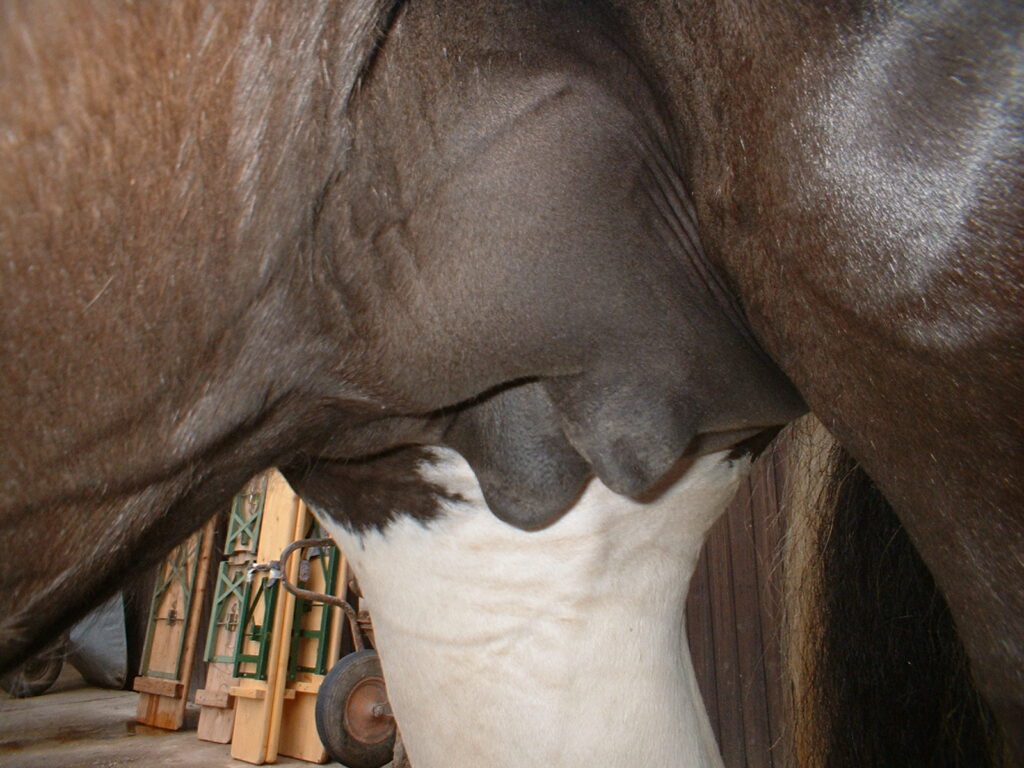
Photo: “File:Pferdeeuter.JPG” by No machine-readable author provided. Borsi112 assumed (based on copyright claims). is licensed under CC BY-SA 3.0.
The Birth of the Foal
Important Different Things to Consider Before the Foaling
- Arrange a functioning foal guard. It is important to monitor the birth so that nothing goes wrong. This can be done with camera surveillance or various sensors.
- Do not disturb the mare unnecessarily during the birth.
- But be prepared to intervene if anything goes wrong.
- Leave the foal and mare with the umbilical cord intact for as long as possible after the birth, as it usually comes off naturally when the mare gets up or the foal tries to get up.

The Tree Stages of Labor
Labor is divided into three stages.
- The first stage, when the mare opens, takes between 30 minutes and 4 hours. At the end of this stage, the amniotic membranes rupture.
- The second stage is where the foal enters the birth canal and is born. It is a very fast stage, taking no more than 20-30 minutes. The foal should be born, usually with the front legs and head first. It’s more deviant and more urgent if the hind legs come first.
- The third stage: the expulsion of the fetal membranes should have occurred within 3 hours.
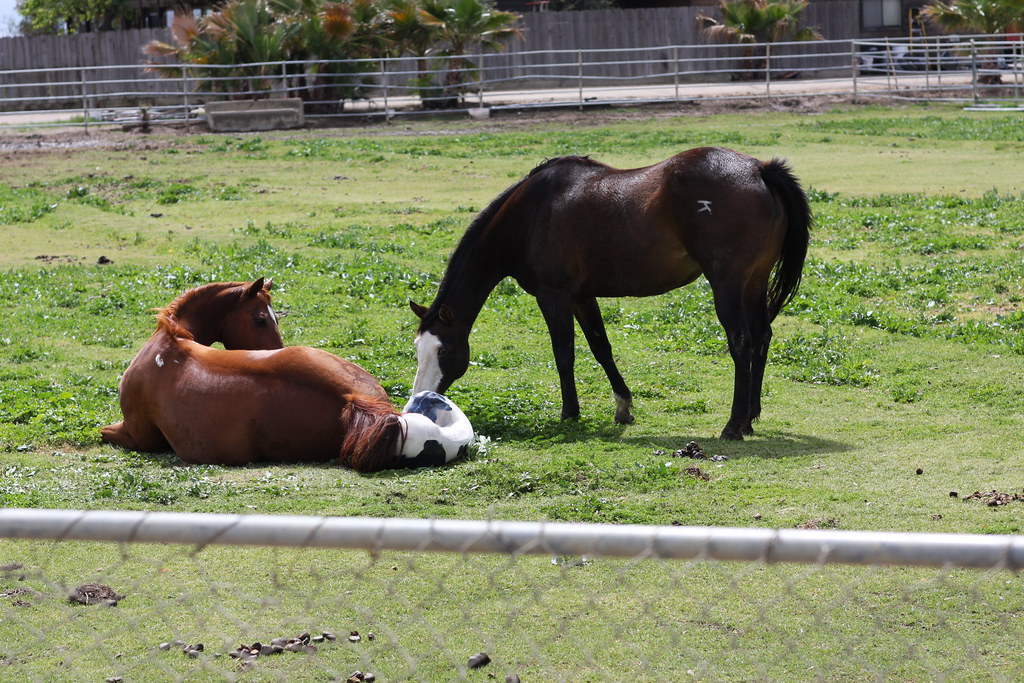
Photo: “IMG_2545” by goldstardeputy is licensed under CC BY 2.0.
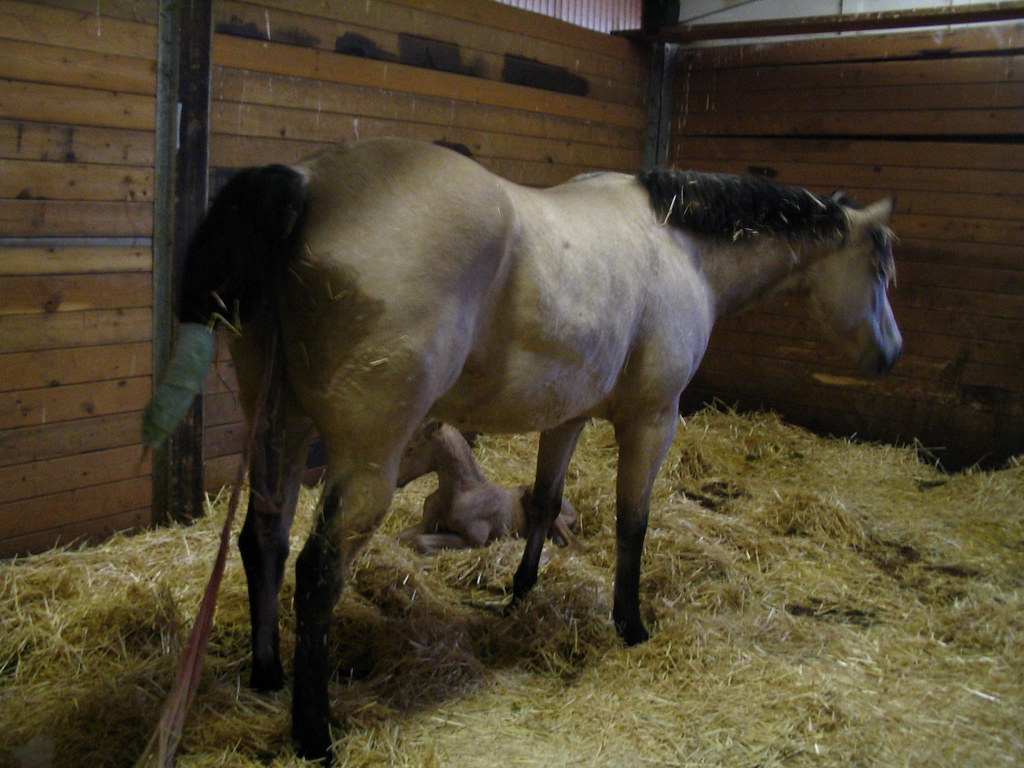
Photo: “Broodmare with tail tied and placenta” by D Coetzee is marked with CC0 1.0.
Red Bag Delivery
If you see a red velvety structure at the beginning of labor instead of the blue and white shimmering amniotic sac, the placenta has detached too early. This risks oxygen deficiency in the fetus and you need to act quickly. The red amniotic membrane must be cut or trimmed to have a chance of saving the foal. The foal is usually in need of intensive care, regardless of rapid action, because of the lack of oxygen.

Photo: “File:Red bag delivery of foal.jpg” by Atsme is licensed under CC BY-SA 4.0.
When Should You Call the Vet?
Call the vet:
- If the mare has started to push and no foal is seen coming out within 10-15 minutes.
- If you see a red bag instead of the white amniotic sac
- If the afterbirth does not release within 3-4 hours. You can try exercising the mare yourself, preferably without the foal.
The First Day of Life
The short version of what should happen on the first day and what is normal is the so-called 1-2-3 rule.

Normal Appearance of a Newborn Foal
- Foals are amazing creatures that are born very ready and prepared to take their first steps within an hour of birth. Because the foal is a prey animal, it needs to get up quickly and be ready to flee. This is very different from human babies, for example. The foal has very long wobbly legs to start with. Because of their long legs and relatively short necks, foals can sometimes find it difficult to reach the ground to graze.
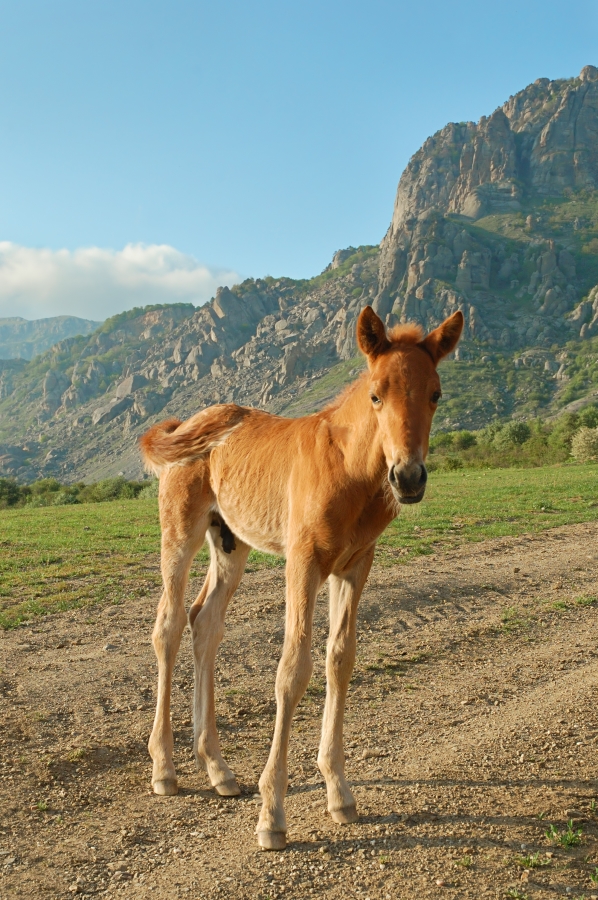
- Foals are born fully furred with mane and tail. The coat color might change in the adult horse. For example, a grey horse is born bay, chestnut, or black.
- The eye color remains the same from birth and throughout the horse’s life. Almost all horses have brown eyes only a few individuals have blue eyes.
- The newborn foal’s ears are quite long in relation to the rest of the head.
- The foal is born with its first teeth and the rest of the milk teeth erupt in the next few weeks.
- The foal is born with foal slippers that look like feathers on the foal’s hooves. These structures protect the uterus from the hard edges of the hoof. Foal slippers are worn off as soon as the foal begins to move on firmer ground.
Normal Behaviors of Newborn Foal
- The foal should be in the breast position within 2-3 minutes.
- Foal should have a sucking reflex within 30 min.
- Ideally the foal should stand up the first time within 60 minutes. If more than 2 hours have elapsed from birth to standing, this is considered abnormal.
- Within 2 hours the foal should have nursed. If more than 4 hours have elapsed from birth to suckling, it is considered abnormal.
- Foal may show signs of “Play” at 2 hours of age, and can usually gallop after 6-7 hours.
Remember that foals are born without antibodies and a developed immune system! The first few hours and early intake of colostrum are vital!
If the foal deviates from normal behavior, the vet should be contacted immediately.
Normal Functions of Newborn Foals
- Mucous membranes of the mouth, eyes, and vagina should be moist and pink. Pale mucous membranes may be seen the first minute after delivery, but should quickly turn pink.
- Stallion foals normally urinate within 6 hours, and mare foals within 11 hours.
- Meconium (earliest feces of newborn foals) should pass in the first 12-24 hours.
When Should You Call the Vet?
Call the vet if:
- If the foal has come out and appears weak and cannot or will not suckle within 2 hours. Tips! Try milking the mare’s udder yourself and feeding the foal with a feeding bottle.
- If the foal does not get its meconium out but walks around, lifts its tail, and becomes droopy, lethargic, or anxious.
The Foal’s First Week of Life
The Outside World
During the first week, it is time to get acquainted with the world outside the stable. If the weather is warm and dry, the foal can go outside with its mother in the first few days after birth. To help them establish good contact with each other, the mare and foal should be left alone and in their own paddock for the first few days. The mare and foal can then be brought together with other horses. Movement is important for both the mare and the foal.
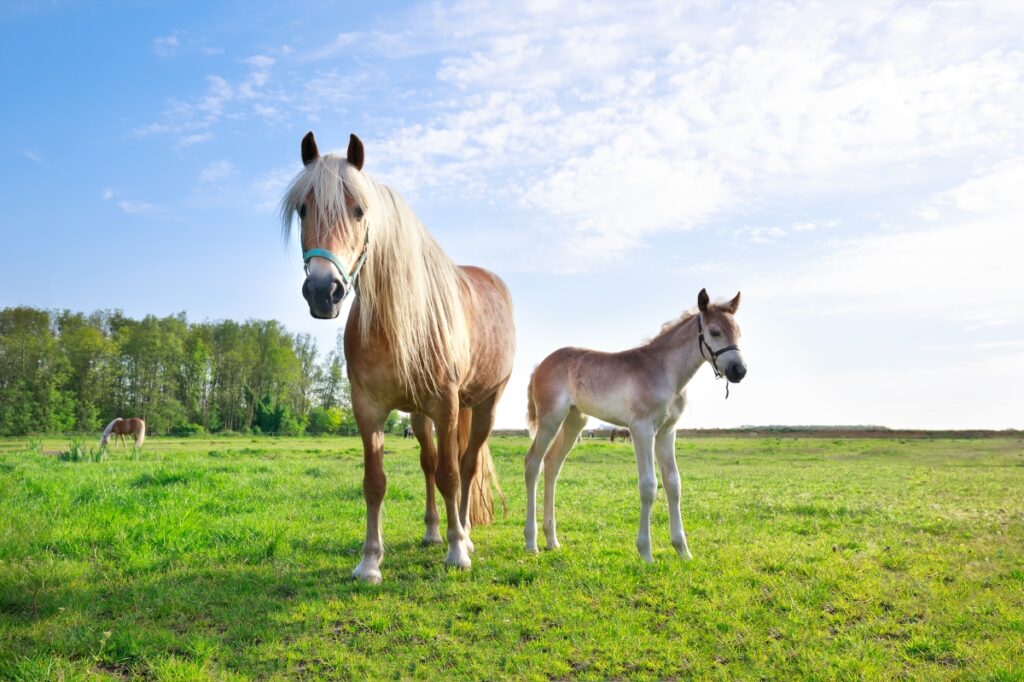
Ideally, they should be released into a paddock that has not been used by older foals or young horses in the last year. This is to reduce the risk of the foal ingesting roundworm eggs. If it is not practical to provide clean pasture, deworming and fecal testing must be carried out.
The Foal’s Feeding Habits
In the first few days, the foal eats 2-3 times an hour, a few decilitres of milk at a time. Most foals start to taste solid foods during the first few days of life and from day three foals can be seen grazing on grass. The colonization of the foal’s large intestine by micro-organisms begins immediately after birth, and after about two months the cellulolytic (fiber-degrading) intestinal flora is established.
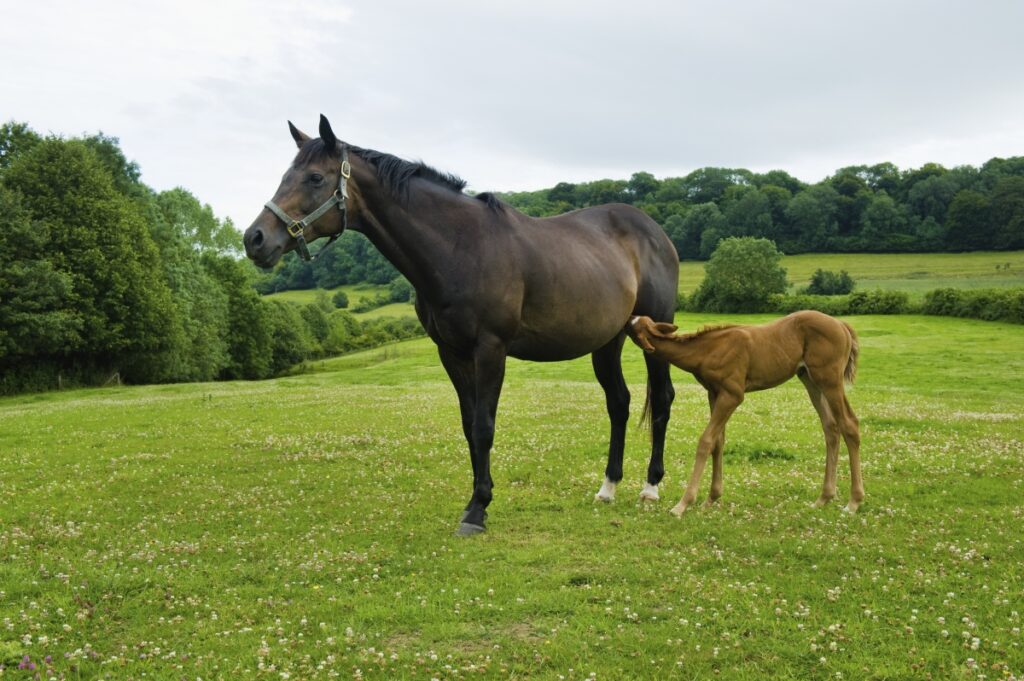
Growth of the Foal
The foal grows very rapidly, reaching about 70% of its adult weight in the first year of life. At the beginning of its life, the foal can grow 1-2 kg a day. The greatest growth occurs during the first three to four weeks when the foal doubles its weight just by feeding its mother’s milk. It is therefore important that the foal meets its nutritional needs and gets sufficient feed. By feeding its mother, it gets all the nutrients it needs from the start. The mare must be on a well-balanced healthy diet to receive all essential nutrients.
In the first year, the horse grows in height. In the second year a little more on the width. In the third year a more even and all-around growth. The rate of growth depends on several factors. Besides feeding and the timing of foaling, it is also influenced by sex and heredity
Weaning
In the wild, natural weaning occurs about 3-4 months before the mare delivers a new foal. The foal is then usually about 8-9 months old. If the mare is not pregnant and foaling, the foal in the wild will last much longer. Domesticated horses are usually weaned much earlier. It should be borne in mind that weaning is a very stressful period in the foal’s life, and should be done in the best possible way and not too early.
Ideal Weaning Procedure
According to some researchers, the best time to wean foals is much later than the usual 4-7 months of age in the United States. At 9-10 months of age, spontaneous weaning usually takes place, which removes the stress of weaning for both the foal and the mare.
Common Problems in the Newborn Foal
Closely monitor foals’ health conditions and act immediately if signs of illness appear. Here are some common problems in foals described.
Low Antibodies
It is not uncommon for foals to have low levels of antibodies in their blood even though they have been fed colostrum (the first milk). The foal may then be weak and susceptible to infection. A blood test can be taken when the foal is 12-24 hours old to check the level of antibodies. The vet can help with the blood test, examine the foal, give it any treatment it needs and assess whether or not it needs to go to the animal hospital.
Premature Born Foal
What is too early? The definition says < 320 days, but there are large individual variations in gestation length. The last 5 days before natural birth is when the foal finally matures. Prematurely born foals are at a higher risk. A foal born prematurely has a short silky coat, curved ears, red tongue, and arched forehead. There are many risks associated with premature birth, usually because the foal’s organs have not matured. For example, immature heat regulation and an immature gastrointestinal tract mean that the foal is not always able to pass the milk, resulting in flatulence, diarrhea, and/or colic. In addition, immature lungs can lead to inadequate oxygenation. Incomplete ossification of the tarsal joints and carpus, as well as laxity of the joints, may lead to malalignment and, in the worst case, permanent joint damage.
Call the vet!
- If the foal is weak and doesn’t nurse
- If the foal is premature born before 320 days of gestation
Sepsis
A major risk factor for sepsis is a low level of antibodies in the blood. The foal is born without antibodies and is dependent on the early intake of sufficient colostrum. In addition, after birth, the foal is exposed to lots of bacteria in its environment. Possible “gateways” for bacteria are the gastrointestinal tract, the umbilicus, and the respiratory tract. The gastrointestinal tract likely is the most important as the specialized cells in the intestine that allow the foal to take up antibodies unfortunately also allow the uptake of bacteria!
Call the vet!
- If the Foal is calmer than normal
- If the foal feeds less frequently – check the mare’s udder!
- If the foal is lying more
- The foal doesn’t have to have a fever, it can also have a hypothermia
- If the foal has dark mucous membranes
- If the foal feels cold around the ears and legs
- If the newborn foal has diarrhea
- If the foal has swollen joints or shows lameness
Meconium Constipation
The meconium usually passes within the first 24 hours after birth (often within 9-12 hours). As colostrum has a laxative effect, meconium blockage may mean that the foal has had too little and is therefore at increased risk of developing sepsis. Constipation is associated with colic, which can range from mild to severe. The foal flags with its tail and cries with a curved back. Enemas can be administered on their own, but with repeated treatments, there is a risk of intestinal irritation and less opportunity for more effective enemas. Often the meconium is stuck far back, but sometimes large amounts are also found further forward in the bowel. In this case, an X-ray or ultrasound of the abdomen may be needed. Most meconium blockages can be resolved without surgery.
Call the vet!
If the meconium doesn´t pass within the first 24 hours
Ruptured Urinary Bladder
The most common cause of a ruptured bladder is likely to be a traumatic injury during birth, but usually, no signs are seen in the foal in the first 24-48 hours after birth. After that, the foal becomes lethargic, feeds less well, and the abdominal cavity increases. Different degrees of colic are seen. The foal stands to urinate but there is little or no urine. Foals with a ruptured bladder may resemble foals with meconium obstruction, but the foal is more likely to stand with its back lowered. Diagnosis is made by an ultrasound examination of the abdomen and blood tests are taken which show typical shifts in blood salt levels. Surgery is required for this condition, but first, the foal must be stabilized. This is done by intravenous drip and possibly emptying urine from the abdomen. A ruptured bladder is more common in colts (male foals).
Call the vet:
- If the foal’s abdomen increases in size
- If the foal shows signs of colic
Limb Abnormalities
It is relatively common for foals to have abnormalities in their limb conformation. It is important that this is noticed early and that the veterinarian and farrier are consulted.
Disclaimer
If your horse is sick, or you suspect it might be sick, always contact your local veterinarian immediately. This article is not a substitute for your local vet, it is a helpful tool to learn more about horses. Your local veterinarian can decide whether your horse needs to be examined or treated.
Sources
Henry, S.; Sigurjónsdóttir, H.; Klapper, A.; Joubert, J.; Montier, G.; Hausberger, M. Domestic Foal Weaning: Need for Re-Thinking Breeding Practices? Animals 2020, 10, 361. https://doi.org/10.3390/ani10020361
Equine Neonatal Medicine E-Book: A Case-Based Approach, Paradis, M.R., 2006, Elsevier Health Sciences

